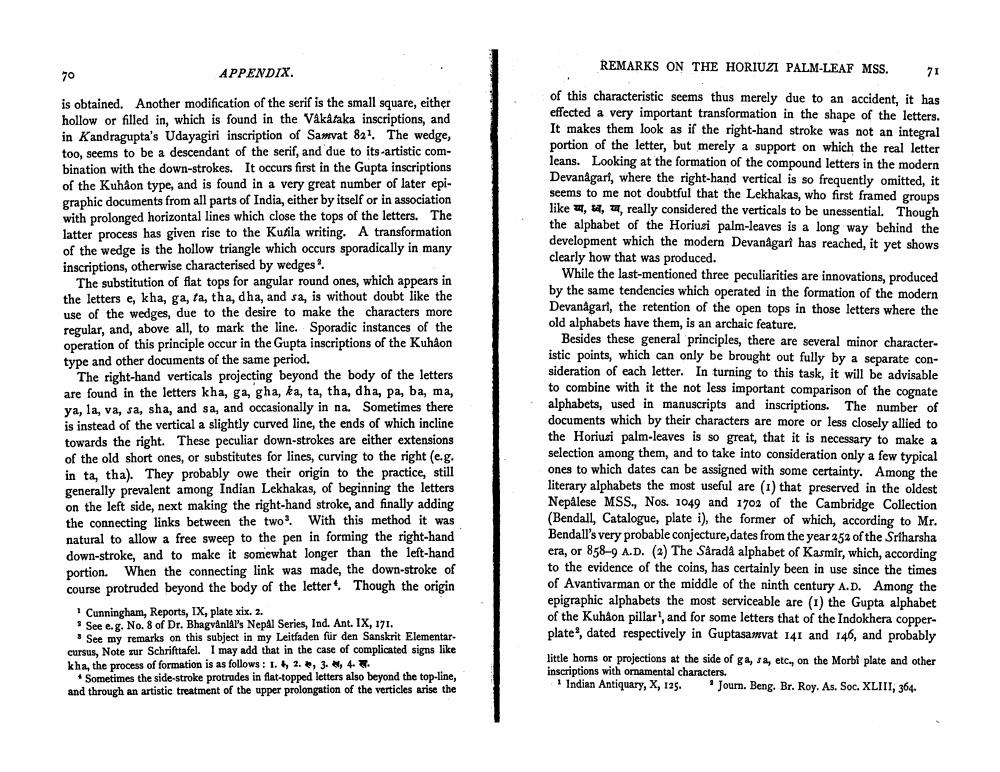________________
REMARKS ON THE HORIUZI PALM-LEAF MSS.
APPENDIX
70
71
is obtained. Another modification of the serif is the small square, either hollow or filled in, which is found in the Vakataka inscriptions, and in Kandragupta's Udayagiri inscription of Samvat 821. The wedge, too, seems to be a descendant of the serif, and due to its-artistic combination with the down-strokes. It occurs first in the Gupta inscriptions of the kuhaon type, and is found in a very great number of later epigraphic documents from all parts of India, either by itself or in association with prolonged horizontal lines which close the tops of the letters. The latter process has given rise to the Kutila writing. A transformation of the wedge is the hollow triangle which occurs sporadically in many inscriptions, otherwise characterised by wedges!
The substitution of flat tops for angular round ones, which appears in the letters e, kha, ga, ta, tha, dha, and sa, is without doubt like the use of the wedges, due to the desire to make the characters more regular, and, above all, to mark the line. Sporadic instances of the operation of this principle occur in the Gupta inscriptions of the Kuhaon type and other documents of the same period.
The right-hand verticals projecting beyond the body of the letters are found in the letters kha, ga, gha, ka, ta, tha, dha, pa, ba, ma, ya, la, va, sa, sha, and sa, and occasionally in na. Sometimes there is instead of the vertical a slightly curved line, the ends of which incline towards the right. These peculiar down-strokes are either extensions of the old short ones, or substitutes for lines, curving to the right(e.g. in ta, tha). They probably owe their origin to the practice, still generally prevalent among Indian Lekhakas, of beginning the letters on the left side, next making the right-hand stroke, and finally adding the connecting links between the two'. With this method it was natural to allow a free sweep to the pen in forming the right-hand down-stroke, and to make it somewhat longer than the left-hand portion. When the connecting link was made, the down-stroke of course protruded beyond the body of the letter Though the origin
Cunningham, Reports, IX, plate xix. 2. * See e. g. No. 8 of Dr. Bhagvanlal's Nepal Series, Ind. Ant. IX, 171.
See my remarks on this subject in my Leitfaden für den Sanskrit Elementar cursus, Note sur Schrifttafel. I may add that in the case of complicated signs like kha, the process of formation is as follows: 1., 2. , 3. , 4.
* Sometimes the side-stroke protrudes in flat-topped letters also beyond the top-line, and through an artistic treatment of the upper prolongation of the verticles arise the
of this characteristic seems thus merely due to an accident, it has effected a very important transformation in the shape of the letters. It makes them look as if the right-hand stroke was not an integral portion of the letter, but merely a support on which the real letter leans. Looking at the formation of the compound letters in the modern Devanagarl, where the right-hand vertical is so frequently omitted, it seems to me not doubtful that the Lekhakas, who first framed groups like , M, really considered the verticals to be unessential. Though the alphabet of the Horiusi palm-leaves is a long way behind the development which the modern Devanagart has reached, it yet shows clearly how that was produced.
While the last-mentioned three peculiarities are innovations, produced by the same tendencies which operated in the formation of the modern Devanagarl, the retention of the open tops in those letters where the old alphabets have them, is an archaic feature.
Besides these general principles, there are several minor characteristic points, which can only be brought out fully by a separate consideration of each letter. In turning to this task, it will be advisable to combine with it the not less important comparison of the cognate alphabets, used in manuscripts and inscriptions. The number of documents which by their characters are more or less closely allied to the Horiusi palm-leaves is so great, that it is necessary to make a selection among them, and to take into consideration only a few typical ones to which dates can be assigned with some certainty. Among the literary alphabets the most useful are (1) that preserved in the oldest Nepalese MSS., Nos. 1049 and 1703 of the Cambridge Collection (Bendall, Catalogue, plate i), the former of which, according to Mr. Bendall's very probable conjecture, dates from the year 252 of the Sriharsha era, or 858-9 A.D. (2) The Sarada alphabet of Kasmir, which, according to the evidence of the coins, has certainly been in use since the times of Avantivarman or the middle of the ninth century A.D. Among the epigraphic alphabets the most serviceable are (1) the Gupta alphabet of the kuhaon pillar', and for some letters that of the Indokhera copperplate", dated respectively in Guptasamvat 141 and 146, and probably little hors or projections at the side of g, ta, etc., on the Morbi plate and other inscriptions with ornamental characters.
Indian Antiquary, X, 125. Joum. Beng. Br. Roy. As. Soc. XLIII, 364.




